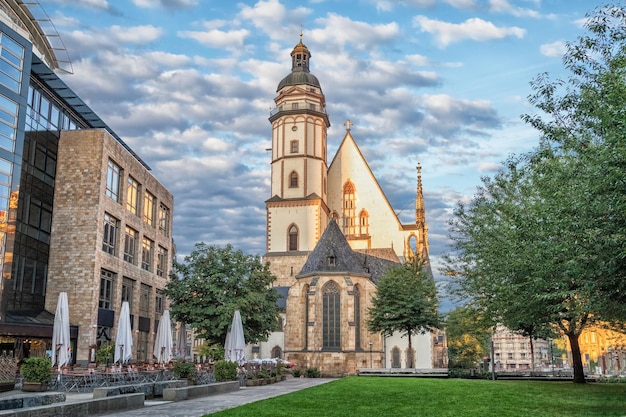음악여행을 계속해 가면, 다음으로 작센의 상업과 학문의 중심지인 라이프치히에 도달한다. 어느 누구라도 성 토마스교회와 여기에서의 바흐의 활동은 다 알고 있다. 그러나 바흐에 앞서 약 200년 동안이나 성 토마스교회는 독일 음악사에서 빛나는 이름을 가지고 있었다. 그리고 바흐가 죽은 뒤 19세기의 라이프치히는 문자 그대로 독일 음악의 중심지가 되었다. 리하르트 바그너가 여기서 태어났고 슈만도 여기서 생활했으며 멘델스존은 세계적으로 유명한 라이프치히 음악원을 창립했고 라이프치히 게반트하우스의 음악회는 전 세계 교향곡 연주의 모범이 되었다.

드레스덴에서 매우 가까운 츠비카우에서는 슈만이 태어났다. 헨델은 할레에서 태어났으며 그곳에서 교육을 받았다. 그러나 헨델이 태어나기 100년 전에 할레는 훌륭한 독일의 오르가니스트의 한 사람인 사무엘 샤이트의 이름으로 음악적으로 유명하게 되었다. 샤이트는 독일 프로테스탄트의 오르간곡, 특히 프렐류드와 변주곡의 창시자이며 중요한 작품에는 1624년에 출판된 타불라투라 노바(Tabulatura Nova-새 악보)가 있다.
할레 근처에는 루터와 관계가 깊으며, 프로테스탄트 음악의 탄생지인 비텐베르크가 있다. 서쪽을 향해서 여행을 계속해 가면, 바이센펠스(Weißenfels)에 도착한다. 여기에는 장대한 성이 있으며 바흐와 헨델 양쪽에 간계되는 음악상 중요한 도시이다.
한 시간 후에는 바이마르에 도착한다. 이곳에서 바흐는 궁정 예배당의 오르가니스트로서 몇 년을 보냈다. 후에 바이마르는 괴테와 실러의 도시로서 그리고 더 후에 리스트는 바이마르를 낭만주의 음악의 중심지로 만들었다.
루터와의 관계로서 유명하며 한번 보아 둘 만한 가치가 있는 훌륭한 고딕 건물을 지닌 에르푸르트를 지나면 아이제나흐에 도착한다. 이곳에서 바흐가 태어났으며 루터는 성서 번역을 했다. 이 도시 근처에 있는 바르트부르크 고성은 오늘날도 아직 중세 미네징거의 활동과 12세기의 시와 음악의 모습을 간직하고 있다.
이 밖에 음악사에 특히 중요한 장소로는 루돌슈타트, 아른슈타트, 괴텐 등의 도시가 있으며, 이러한 여러 도시는 바흐와의 관계 때문에 유명하다.
보헤미아와의 국경 근처의 작센 지방은 다른 분야로서는 보잘것없지만 음악적으로는 중요한 곳이다. 여기에는 프라이 부르크, 안나부르크, 요하힘슈탈(St. Jachimsthal), 지타우(Zittau) 등의 도시가 있으며 특히 지타우에는 17세기에 가장 인기가 높았던 독일 작곡가 안드레아스 함머슈미트(Andreas Hammerschmidt)가 살고 있었다. 그의 모테트 "종교적 콘체르트( Geistliche Konzerte), 종교적 마드리갈, 종교적 대화극 등은 독일의 모든 프로테스탄트 지방-튀링겐의 삼림지대나, 작센과 보헤미아의 조그마한 도시나 외딴 촌락에서까지도 불리어졌다.
60권이 넘는 독일음악 기념집의 방대한 출판은 17세기의 독일 프로테스탄트의 보고이다. 여기에는 샤이트, 히에로니무스 프레토리우스(Hieronymus Praetorius) , 함머슈미트, 그리고 요한 제바스티안 바흐의 선조들, 라이프치히의 바흐의 선임자인 요한 쿠나우, 멜히오르 프랑크, 요한 로젠뮐러, 17세기 최대의 독일가곡 작가인 아담 크리거, 헨델의 스승인 프리드리히 빌헬름 차호, 바흐에게 큰 영향을 끼친 오르간 음악의 대가들인 뤼네부르크의 게오르그 뵙과 바이마르의 요한 발터, 뤼베크의 북스테후데, 뉘른베르크의 파헬벨 등의 작품이 포함되어 있다.
https://youtu.be/yXbhq66wbSw?si=LTxlUnPwkozmvA7I
If you continue your musical journey, you will reach Leipzig, the commercial and academic center of Saxony. Everyone is aware of St. Thomas Church and Bach's activities here. However, St. Thomas Church had a prominent name in German music history for about 200 years before Bach. And after Bach's death, Leipzig in the 19th century literally became the center of German music. Richard Wagner was born here, Schumann lived here, and Mendelssohn founded the world-famous Leipzig Conservatory, and Leipzig Gewandhaus' concert became a model for symphony performances around the world.
In Zwickau, which is very close to Dresden, Schumann was born. Handel was born in Halle and was educated there. However, 100 years before Handel's birth, Halle became musically famous under the name of Samuel Scheitte, one of the great German organists. Scheitte is the founder of organ music of the German Protestant, especially the Prelude and Variations, and an important work includes Tabulatura Nova, published in 1624.
Near Halle is Wittenberg, which has a deep relationship with Luther and is the birthplace of protestant music. If you continue your journey westward, you will arrive in Weißenfels. There is a magnificent castle here, and it is a music-important city between both Bach and Handel.
An hour later, he arrives in Weimar. Here, Bach spent several years as an organist in a court chapel. Weimar later became the city of Goethe and Schiller, and later Liszt made Weimar the center of romantic music.
You will arrive in Eisenach after passing through Erfurt, which is famous for its relationship with Luther and has a great Gothic building worth a look. Here, Bach was born, and Luther translated the Bible. The ancient city of Wartburg near this city still retains the medieval Minnesinger's activities and the 12th-century poetry and music.
Other particularly important places in music history include cities such as Rudolstadt, Arnstadt, and Goetten, and many of these cities are famous because of their relationship with Bach.
The province of Saxony, near its border with Bohemia, is insignificant for other fields but is of musical importance. These include cities such as Freiburk, Annaburg, St. Jachimsthal, and Zittau, especially in Zittau, where Andreas Hammerschmidt, a German composer who was the most popular in the 17th century, lived. His motets, "Geistliche Konzerte," "Religious Madrigals," and religious dialogues were sung in all the woodlands of the Protestant region of Germany, as well as in small cities and remote villages in Saxony and Bohemia.
The vast publication of more than 60 German music anniversaries is a repository of 17th-century German Protestants. They include works by Schaitt, Hieronymus Pretorius, Hammerschmidt, and Johann Sebastian Bach's ancestors; Johann Kunau, Melchior Frank, Johann Rosenmüller, Bach's predecessors, Adam Krieger, the greatest German composer of the 17th century; Friedrich Wilhelm Chahaw, Handel's teacher; Georg Böw of Lüneburg and Johann Walter of Weimar, and North Stehude of Lünberg and Pachelbel of Nuremberg.
17세기 독일음악의 풍토 1(The climate of German music in the 17th century 1)
종교개혁이 시작된 뒤 약 80년 동안은 로마 가톨릭교회의 뜻에 위반되는 모든 문화적 발전에 대한 적대적 생각과 종교문제에 대한 불관용(不寬容)의 태도는 정점에 이르고, 마침내 1600년에 뛰어
zeong.tistory.com
'Music Story > 서양음악사' 카테고리의 다른 글
| 여러나라의 바로크 특징(Baroque characteristics of many countries) (104) | 2024.03.06 |
|---|---|
| 바로크 음악의 소리에 대한 이상(The ideal of the sound of baroque music) (101) | 2024.03.01 |
| 17세기 독일음악의 풍토 1(The climate of German music in the 17th century 1) (112) | 2024.02.10 |
| 오라토리오의 발생(Occurrence of Oratorio) (125) | 2024.02.08 |
| 통주저음과 협주양식 (95) | 2024.02.02 |



